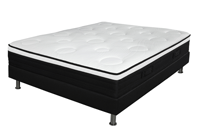3 lessons from Furniture/Today’s Bedding Conference
The bedding industry is actively looking inward, undergoing a self-evaluation process to thoroughly understand the deep vein of consumer dissatisfaction that direct sellers have tapped into.
Sitting in the audience at Furniture/Today's Bedding Conference last week, I was struck again and again by the extent to which direct-to-consumer, bed-in-a-box mattress sellers have disrupted the traditional bedding industry. Although no one would describe BinB as an existential threat, it’s abundantly clear that this once derided model now has this industry’s full attention.
It’s also clear that one way the industry has chosen to respond is through that sincerest form of flattery — imitation. That doesn’t mean every major mattress player is going to launch their own version of BinB (yet). Instead the bedding industry is actively looking inward, undergoing a self-evaluation process to thoroughly understand the deep vein of consumer dissatisfaction that direct sellers have tapped into.
It’s a healthy and constructive response to addressing a disruptive market force, one that bodes well for the bedding industry and consumers. It’s also offers valuable lessons for the furniture industry at large.

Here are three things that came out of last week’s F/T conference that could prove instructive to the furniture industry in the years to come.
1. Choice is not always a gift. Retail merchandising over the past two decades has been based on the concept of offering the consumer more: more features, more choices. Massive selection was the power play of the superstore concept that defined retail in the late 1980s and early ’90s. Turns out all that choice is unpleasant white noise for many of today’s consumers. The lesson here from BinB is one size may not fit all, but it can fit enough to build a business, particularly if you convince the consumer it’s the right one for them.
2. Keep it simple. This applies not just to merchandise assortment, but, as importantly, also to the shopping process. Look at the top BinB websites, and you’ll notice a sparse landscape of graphics, images and buttons to push. The whole shopping process can be completed in 10 minutes without a lot of reading to figure out what button to push next or what choice to make next. Today’s consumer is overwhelmed by information in every other aspect of their lives. They’ve also likely done their homework before moving to the actual purchase decision. The faster, easier and more intuitive you can make the final steps, the higher your chances of success.
3. Phone it in. The digital revolution has boiled down to this. That little device most consumers carry in their pocket is now the single most-important interaction they have in their lives. And, yes, I realize I’m implying that the phone is more important to some of today’s consumers than people are. Look around. Watch any group of people, and see how many are ignoring the live humans in front of them to interact with their phones. If you’re not reaching consumers on their phones you’re not reaching them. Period. Mobile is the future. The future is now.
This doesn’t even begin to scratch the surface of what came out of this event. For complete coverage come see upcoming issues of Furniture/Today.





 沪公网安备31010402003309号
沪公网安备31010402003309号



